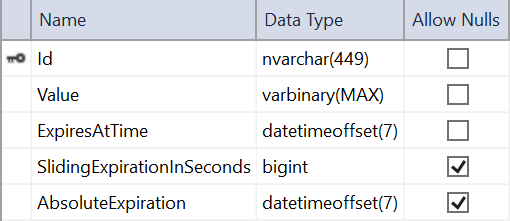Performance - Caching - Distributed caching
In this article
-
Is coherent (consistent) across requests to multiple servers.
-
Survives server restarts and app deployments.
-
Doesn't use local memory.
Prerequisites
-
For a Redis distributed cache, Microsoft.Extensions.Caching.StackExchangeRedis.
-
For SQL Server, Microsoft.Extensions.Caching.SqlServer.
-
For the NCache distributed cache, NCache.Microsoft.Extensions.Caching.OpenSource.
IDistributedCache interface
-
Get, GetAsync: Accepts a string key and retrieves a cached item as a byte[] array if found in the cache.
-
Set, SetAsync: Adds an item (as byte[] array) to the cache using a string key.
-
Refresh, RefreshAsync: Refreshes an item in the cache based on its key, resetting its sliding expiration timeout (if any).
-
Remove, RemoveAsync: Removes a cache item based on its string key.
Establish distributed caching services
-
Distributed Redis cache
-
Distributed Memory Cache
-
Distributed SQL Server cache
-
Distributed NCache cache
-
Distributed Azure CosmosDB cache
Distributed Redis Cache
-
Create an Azure Cache for Redis.
-
Copy the Primary connection string (StackExchange.Redis) to Configuration.
-
Local development: Save the connection string with Secret Manager.
-
Azure: Save the connection string in the App Service Configuration or another secure store.
-
builder.Services.AddStackExchangeRedisCache(options =>
{
options.Configuration = builder.Configuration.GetConnectionString("MyRedisConStr");
options.InstanceName = "SampleInstance";
});
Distributed Memory Cache
-
In development and testing scenarios.
-
When a single server is used in production and memory consumption isn't an issue. Implementing the Distributed Memory Cache abstracts cached data storage. It allows for implementing a true distributed caching solution in the future if multiple nodes or fault tolerance become necessary.
builder.Services.AddDistributedMemoryCache();
Distributed SQL Server Cache
dotnet sql-cache create "Data Source=(localdb)/MSSQLLocalDB;Initial Catalog=DistCache;Integrated Security=True;" dbo TestCache
Table and index were created successfully.

Note An app should manipulate cache values using an instance of
IDistributedCache, not a SqlServerCache.
builder.Services.AddDistributedSqlServerCache(options =>
{
options.ConnectionString = builder.Configuration.GetConnectionString(
"DistCache_ConnectionString");
options.SchemaName = "dbo";
options.TableName = "TestCache";
});
Note A ConnectionString (and optionally, SchemaName and TableName) are typically stored outside of source control (for example, stored by the Secret Manager or in
appsettings.json/appsettings.{Environment}.jsonfiles). The connection string may contain credentials that should be kept out of source control systems.
Distributed NCache Cache
-
Install NCache open source NuGet.
-
Configure the cache cluster in client.ncconf.
-
Add the following code to
Program.cs:
builder.Services.AddNCacheDistributedCache(configuration =>
{
configuration.CacheName = "democache";
configuration.EnableLogs = true;
configuration.ExceptionsEnabled = true;
});
Distributed Azure CosmosDB Cache
Reuse an existing client
services.AddCosmosCache((CosmosCacheOptions cacheOptions) =>
{
cacheOptions.ContainerName = Configuration["CosmosCacheContainer"];
cacheOptions.DatabaseName = Configuration["CosmosCacheDatabase"];
cacheOptions.CosmosClient = existingCosmosClient;
cacheOptions.CreateIfNotExists = true;
});
Create a new client
services.AddCosmosCache((CosmosCacheOptions cacheOptions) =>
{
cacheOptions.ContainerName = Configuration["CosmosCacheContainer"];
cacheOptions.DatabaseName = Configuration["CosmosCacheDatabase"];
cacheOptions.ClientBuilder = new CosmosClientBuilder(Configuration["CosmosConnectionString"]);
cacheOptions.CreateIfNotExists = true;
});
Use the distributed cache
app.Lifetime.ApplicationStarted.Register(() =>
{
var currentTimeUTC = DateTime.UtcNow.ToString();
byte[] encodedCurrentTimeUTC = System.Text.Encoding.UTF8.GetBytes(currentTimeUTC);
var options = new DistributedCacheEntryOptions()
.SetSlidingExpiration(TimeSpan.FromSeconds(20));
app.Services.GetService<IDistributedCache>()
.Set("cachedTimeUTC", encodedCurrentTimeUTC, options);
});
public class IndexModel : PageModel
{
private readonly IDistributedCache _cache;
public IndexModel(IDistributedCache cache)
{
_cache = cache;
}
public string? CachedTimeUTC { get; set; }
public string? ASP_Environment { get; set; }
public async Task OnGetAsync()
{
CachedTimeUTC = "Cached Time Expired";
var encodedCachedTimeUTC = await _cache.GetAsync("cachedTimeUTC");
if (encodedCachedTimeUTC != null)
{
CachedTimeUTC = Encoding.UTF8.GetString(encodedCachedTimeUTC);
}
ASP_Environment = Environment.GetEnvironmentVariable("ASPNETCORE_ENVIRONMENT");
if (String.IsNullOrEmpty(ASP_Environment))
{
ASP_Environment = "Null, so Production";
}
}
public async Task<IActionResult> OnPostResetCachedTime()
{
var currentTimeUTC = DateTime.UtcNow.ToString();
byte[] encodedCurrentTimeUTC = Encoding.UTF8.GetBytes(currentTimeUTC);
var options = new DistributedCacheEntryOptions()
.SetSlidingExpiration(TimeSpan.FromSeconds(20));
await _cache.SetAsync("cachedTimeUTC", encodedCurrentTimeUTC, options);
return RedirectToPage();
}
}
Recommendations
-
Existing infrastructure
-
Performance requirements
-
Cost
-
Team experience
Additional resources
-
Redis Cache on Azure
-
SQL Database on Azure
-
ASP.NET Core
IDistributedCacheProvider for NCache in Web Farms (NCache on GitHub) -
Repository README file for Microsoft.Extensions.Caching.Cosmos
-
Cache in-memory in ASP.NET Core
-
Detect changes with change tokens in ASP.NET Core
-
Response caching in ASP.NET Core
-
Response Caching Middleware in ASP.NET Core
-
Cache Tag Helper in ASP.NET Core MVC
-
Distributed Cache Tag Helper in ASP.NET Core
-
Host ASP.NET Core in a web farm